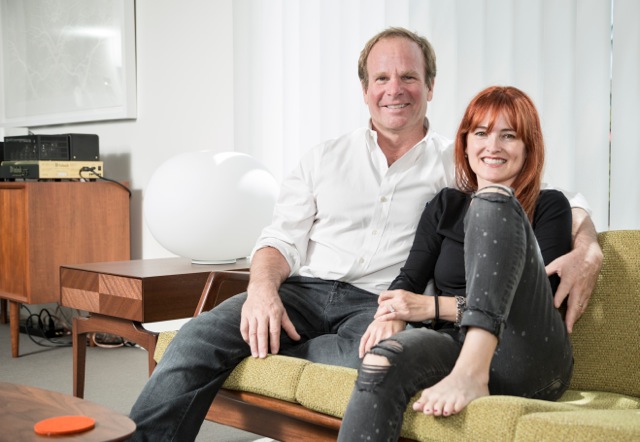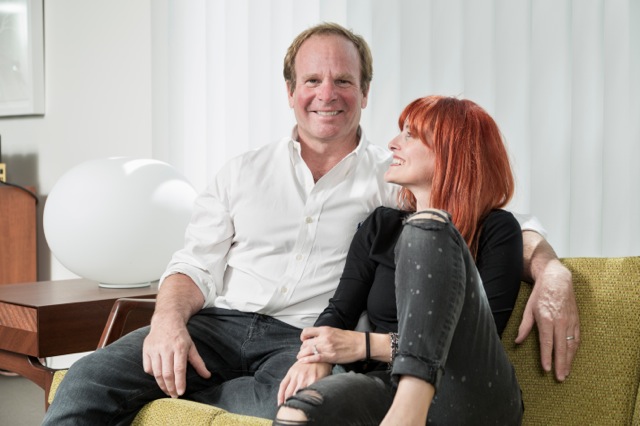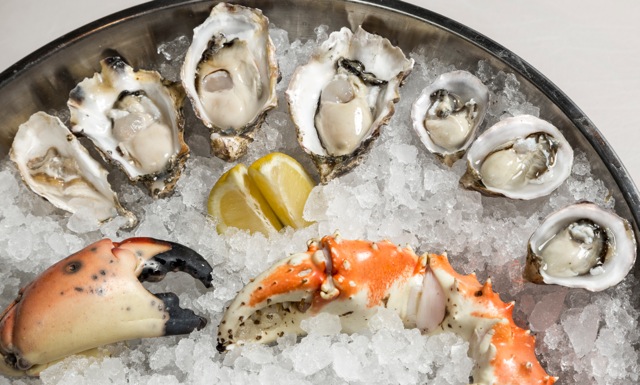
What do yoga, art and cuisine have in common? They are the key ingredients behind a successful restaurant group that has spearheaded better neighborhood connectivity through inspired conversation and phenomenal food. The creative couple behind the Le Grande Orange (LGO) Hospitality brand, Bob Lynn and Sara Abbott, spoke to me about how they got together, their artistic outlets and the importance of building communities. They have undoubtedly helped pave the way to the Arcadia neighborhood’s success, starting with the original LGO Grocery over 10 years ago.
Bob Lynn hails from the Windy City, where there is an immense sense of community built through retail, food and public activity. Lynn studied business in college, but his heart was always in the kitchen, having spent much his life there from age 13. Combining his savvy for economics with his passion for the fry pan, early in his career he helped launch and operate established concepts including Houston’s and Hillstone.
Bob and Sara recently purchased a 1963 Al Beadle–designed home—simply known as [Beadle House] No. 11. They humbly consider themselves the new caretakers of this iconic home, once the personal residence of Al and his wife, Nancy. Lynn and Abbott had been living primarily in Santa Monica, but now with more restaurants in Phoenix than California, it made sense for them to have their primary home here in the Valley. The house and its grounds offer a tranquil sanctuary from the busy street life of Santa Monica that they’d grown accustomed to. Additionally, it offers the practical logistics of being just down the road from many of their establishments.
A focus on quality and approachability is thoroughly ingrained in their company ethos, from top to bottom, and the pair work closely with local purveyors, chefs, designers and artisans. This formula has helped to create the open-air market feel of LGO Grocery; the ground-up Australian beach house vibe at Buck and Rider (serving flown-in-fresh seafood); the California casual ambiance of Chelsea’s Kitchen; and the quirky Will Bruder–designed architecture of Ingo’s Tasty Food, serving up burgers, comfort food and delicious sangria.
During my time with Bob and Sara, their genuine practice of maintaining the quality and boldness of their concepts was clear to see. Every detail is notable. Equally interesting was the insight into their operations, giving a perspective on how they’ve arrived at where they are today.

JAVA: How did you two meet?
Bob Lynn: I was sitting in LGO Grocery one morning and a voice from across the room said, “I know you’re a real art lover, and I’ve got some local Arizona artists I’d like to show you.” This voice happened to be that of an art broker I know. She pulled out a portfolio with the work of a half dozen artists, and I came across these paintings of barns that I thought were really well done, so I asked about them. Turns out, the artist was Sara Abbott, who was originally from Portland.
I informed her [the broker] I wanted to see those pieces in person, and within the next few weeks, the broker came over with several pieces and brought the artist as well. I saw the work, loved it and bought it. Strangely, I had immediately felt something for Sara as well, with no real idea of who she was.
The long and the short of it is, it wasn’t until five years later that we had our first date. During that long interim we were in different places in our lives. I had just moved to Los Angeles and was opening our Pasadena restaurant, but Sara and I stayed in touch. Years later, we had an opening coming up in Arizona, so I had my assistant start calling people on our list, but first I would describe who he was going to call. When I got to Sara, I explained that she was a really cool and talented artist and pointed to a painting that was hanging in my house. The following day as Nicholas and I reviewed the contacts he had made, at the end of the conversation he said that he’d talked to Sara and that she would love to come. That was 10 years ago.
Sara Abbott: I was in Arizona working at an art studio called 3CarPileUp with Randy Slack, James Angel and David Dauncey. I moved here in 1991 for school, to study photography. I was successful in doing my art and, as Bob mentioned, we first met through my work.
JAVA: Bob, describe your typical workday.
BL: I start my day by checking in with all of the restaurants (emails, phone calls, touching base). I also try to find time to do 90 minutes of yoga and meditation. It is a way to focus and reach much more clarity. When you have a special organization, you need to be a special leader. Yoga helps me be that.
At LGO Grocery we have someone here from about 4:30 a.m. There are lots of moving parts, so it’s important to make sure everything is running smoothly. Additionally, there are always things that we are working to improve, upgrade and rebuild. For example, in our backyard, we have a prototype picnic bench (for future use in LGO’s Java Garden) to address the needs of a more stable surface. Tom Tuberty created the prototype. He is an artist with a welding mask that has been a loyal customer and partner for many years.
One of the most important things that Sara and I do for each other is to check the clarity of work we are doing. Creative people start with a goal in mind, to conceptualize and execute their point of view. What’s special about our relationship, friendship and marriage, is that we are constantly challenging each other to make sure that the end viewer/user can best understand our original intention. In order to be able to do that, there has to be a deep level of trust with each other; being vulnerable, listening and demonstrating a great degree of patience. It’s a very special part of “us” and what we do together that leverages both of our work.
JAVA: Sara, your art seems to have no boundaries. Can you explain what inspires your different subjects and media?
SA: For me, art is a way of contributing something to the world. I like to help put that vibration out there. When I am creating, as with most artists, my intention lies within the art. The viewer or the collector has his or her own set of filters, so as an artist, you hope that your intent comes across in each and every piece. There is definitely joy in the takeaway of my art being fully understood.
I am almost always working. Oftentimes that means just picking up the camera and capturing something new. Then bringing it back to the studio and using paint to transcribe my perspective. The types of media I use are pretty broad, but my newest is printer ink—ink from the waste tanks of large-format printers. Throughout most of my career, I have used these printers for my mixed media and photography work. Over the years, I’ve collected the leftover ink—a rich, saturated, crude oil–like substance—in jars. I kept saying that someday I would have a good idea for it. I have finally utilized these inks to create abstract pieces that I will be showing in my Los Angeles studio on May 1. These poured and manipulated works are essentially my take on “green” paintings. It’s quite a process, as they take around six months to fully dry.
JAVA: Bob, how are your new restaurant concepts conceived?
BL: It always starts with a location and a community, rather than coming up with a business model that just gets rolled out. We try to look at the local surroundings and deliver something that is true to our brand, but also something that really adds to the lives of the people in that area. We love high quality, but we don’t focus on formality. We like things that are emotionally irresistible and compelling, yet useful at the same time.
LGO started as a sort of community center, being one of the few commercial properties in the area that people could walk and ride bikes to. Buck and Rider is in a very powerful location, so we wanted to create an important seafood restaurant there. My business partner, Adam Streckler, is from New Orleans and he brings a lot of knowledge and experience.
The Buck and Rider building was inspired by a house on a stretch of the Australian coast called Noosa Beach. I wanted it to have a big city, cosmopolitan feel inside, yet remain casual. We had to think about what was needed, adding a layer to the area that would compel people to use it. Let’s face it, fresh seafood is expensive, so it puts a bigger burden on us to execute and deliver value.
Buck and Rider resonates a nomadic, remote and untouched feel. When you think about seafood, you are thinking about clean, cool water and a light, healthy way to eat. The interior, which we did ourselves, started with the idea of one big room, while really thinking about the brasseries and coffee shops of Paris and Berlin. The energy is charged and the environment intended to be fun. It is a room where everyone is included, offering a sense of relief and comfort where all people can feel at home.

JAVA: What is next for LGO Hospitality?
BL: The first thing that comes to my mind is “how do we make what we are doing even better?” As a company, we get as much enjoyment from perfecting and improving what we already have, as we do creating something new. The market is always changing and our customers are always evolving and becoming more progressive. So the first question to ourselves is, “How are we getting better?” Look for a tasting room at the LGO Bar and brunch at Buck and Rider, with a very exciting menu.
Our newest concept is housed in a 1946 building in Santa Monica called Ingo’s Tasty Diner, serving up farm-to-table cuisine. We are looking at more opportunities in Southern California on the horizon. Lastly, we are committed to New York—Lower East Side, Brooklyn area—but that’s as much as I can tell you for now.


